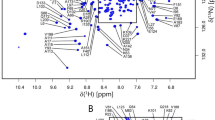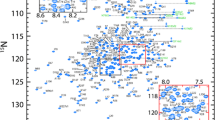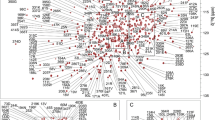Abstract
Phosphoenolpyruvate binding to the C-terminal domain (EIC) of enzyme I of the bacterial phosphotransferase system (PTS) initiates a phosphorylation cascade that results in sugar translocation across the cell membrane and controls a large number of essential pathways in bacterial metabolism. EIC undergoes an expanded to compact conformational equilibrium that is regulated by ligand binding and determines the phosphorylation state of the overall PTS. Here, we report the backbone 1H, 15N and 13C chemical shift assignments of the 70 kDa EIC dimer from the thermophilic bacterium Thermoanaerobacter tengcongensis. Assignments were obtained at 70 °C by heteronuclear multidimensional NMR spectroscopy. In total, 90% of all backbone resonances were assigned, with 264 out of a possible 299 residues assigned in the 1H–15N TROSY spectrum. The secondary structure predicted from the assigned backbone resonance using the program TALOS+ is in good agreement with the X-ray crystal structure of T. tengcongensis EIC. The reported assignments will allow detailed structural and thermodynamic investigations on the coupling between ligand binding and conformational dynamics in EIC.


Similar content being viewed by others
References
Clore GM, Gronenborn AM (1998) Determining the structures of large proteins and protein complexes by NMR. Trends Biotechnol 16:22–34
Clore GM, Venditti V (2013) Structure, dynamics and biophysics of the cytoplasmic protein-protein complexes of the bacterial phosphoenolpyruvate: sugar phosphotransferase system. Trends Biochem Sci 38:515–530. doi:10.1016/j.tibs.2013.08.003
Delaglio F, Grzesiek S, Vuister GW, Zhu G, Pfeifer J, Bax A (1995) NMRPipe: a multidimensional spectral processing system based on UNIX pipes. J Biomol NMR 6:277–293
Deutscher J, Ake FM, Derkaoui M, Zebre AC, Cao TN, Bouraoui H, Kentache T, Mokhtari A, Milohanic E, Joyet P (2014) The bacterial phosphoenolpyruvate:carbohydrate phosphotransferase system: regulation by protein phosphorylation and phosphorylation-dependent protein-protein interactions. Microbiol Mol Biol Rev 78:231–256. doi:10.1128/MMBR.00001-14
Navdaeva V, Zurbriggen A, Waltersperger S, Schneider P, Oberholzer AE, Bahler P, Bachler C, Grieder A, Baumann U, Erni B (2011) Phosphoenolpyruvate: sugar phosphotransferase system from the hyperthermophilic Thermoanaerobacter tengcongensis. BioChemistry 50:1184–1193
Oberholzer AE, Bumann M, Schneider P, Bachler C, Siebold C, Baumann U, Erni B (2005) Crystal structure of the phosphoenolpyruvate-binding enzyme I-domain from the Thermoanaerobacter tengcongensis PEP: sugar phosphotransferase system (PTS). J Mol Biol 346:521–532
Patel HV, Vyas KA, Savtchenko R, Roseman S (2006) The monomer/dimer transition of enzyme I of the Escherichia coli phosphotransferase system. J Biol Chem 281:17570–17578. doi:10.1074/jbc.M508965200
Pervushin K, Riek R, Wider G, Wuthrich K (1997) Attenuated T2 relaxation by mutual cancellation of dipole-dipole coupling and chemical shift anisotropy indicates an avenue to NMR structures of very large biological macromolecules in solution. Proc Natl Acad Sci USA 94:12366–12371
Postma PW, Lengeler JW, Jacobson GR (1996) Phosphoenolpyruvate:carbohydrate phosphotransferase systems. In: Neidhardt FC, Lin EC, Curtiss R (eds) Escherichia coli and Salmonella: cellular and molecular biology, pp 1149–1174. ASM Press, Washington, DC
Schwieters CD, Suh JY, Grishaev A, Ghirlando R, Takayama Y, Clore GM (2010) Solution structure of the 128 kDa enzyme I dimer from Escherichia coli and its 146 kDa complex with HPr using residual dipolar couplings and small- and wide-angle X-ray scattering. J Am Chem Soc 132:13026–13045
Shen Y, Delaglio F, Cornilescu G, Bax A (2009) TALOS+: a hybrid method for predicting protein backbone torsion angles from NMR chemical shifts. J Biomol NMR 44:213–223
Teplyakov A, Lim K, Zhu PP, Kapadia G, Chen CC, Schwartz J, Howard A, Reddy PT, Peterkofsky A, Herzberg O (2006) Structure of phosphorylated enzyme I, the phosphoenolpyruvate:sugar phosphotransferase system sugar translocation signal protein. Proc Natl Acad Sci USA 103:16218–16223
Tugarinov V, Muhandiram R, Ayed A, Kay LE (2002) Four-dimensional NMR spectroscopy of a 723-residue protein: chemical shift assignments and secondary structure of malate synthase g. J Am Chem Soc 124:10025–10035
Ulrich EL, Akutsu H, Doreleijers JF, Harano Y, Ioannidis YE, Lin J, Livny M, Mading S, Maziuk D, Miller Z, Nakatani E, Schulte CF, Tolmie DE, Kent Wenger R, Yao H, Markley J (2008) BioMagResBank. Nucleic Acids Res 36:D402–D408
Venditti V, Clore GM (2012) Conformational selection and substrate binding regulate the monomer/dimer equilibrium of the C-terminal domain of Escherichia coli enzyme I. J Biol Chem 287:26989–26998. doi:10.1074/jbc.M112.382291
Venditti V, Ghirlando R, Clore GM (2013) Structural basis for enzyme I inhibition by alpha-ketoglutarate. ACS Chem Biol 8:1232–1240. doi:10.1021/cb400027q
Venditti V, Schwieters CD, Grishaev A, Clore GM (2015a) Dynamic equilibrium between closed and partially closed states of the bacterial Enzyme I unveiled by solution NMR and X-ray scattering. Proc Natl Acad Sci USA 112:11565–11570. doi:10.1073/pnas.1515366112
Venditti V, Tugarinov V, Schwieters CD, Grishaev A, Clore GM (2015b) Large interdomain rearrangement triggered by suppression of micro- to millisecond dynamics in bacterial enzyme I. Nat Commun 6:5960. doi:10.1038/ncomms6960
Acknowledgements
This work was supported by startup funding from Iowa State University (V.V.).
Author information
Authors and Affiliations
Corresponding author
Rights and permissions
About this article
Cite this article
Dotas, R.R., Venditti, V. 1H, 15N, 13C backbone resonance assignment of the C-terminal domain of enzyme I from Thermoanaerobacter tengcongensis . Biomol NMR Assign 12, 103–106 (2018). https://doi.org/10.1007/s12104-017-9788-x
Received:
Accepted:
Published:
Issue Date:
DOI: https://doi.org/10.1007/s12104-017-9788-x




